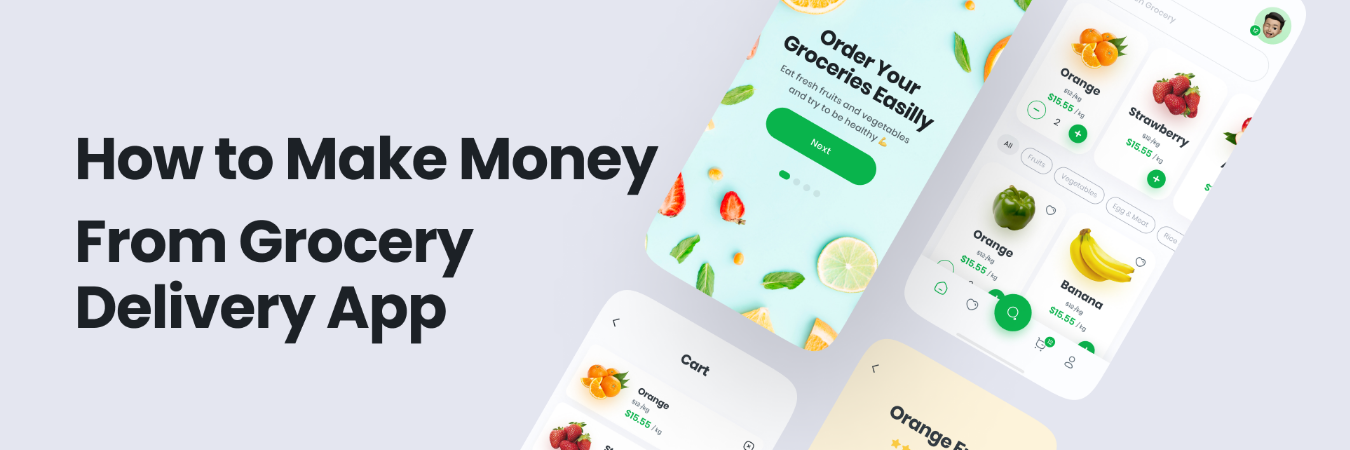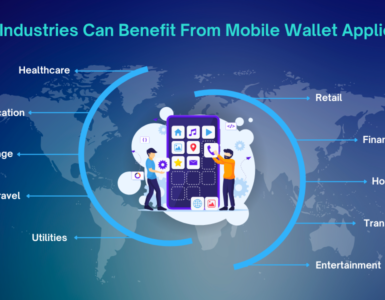Have you noticed how life speed has accelerated in the past ten years? Household routines are seldom used. People are becoming more and more eager to employ on-demand services to handle routine chores like house cleaning, shopping, cooking, laundry, and maintenance. Grocery delivery applications have emerged as a major boon in the struggle for work-life balance. The ideal conditions exist for entrepreneurs who wish to develop a meal delivery app thanks to rising demand, growing consumer confidence in online services, and easy access to the market for businesses.
How are software programs like Instacart created? Let’s investigate!
WHY START A GROCERY DELIVERY BUSINESS?
Large and well-known grocery delivery app development companies like Instacard, Postmates, Peapod, Shipt, and Amazon Prime already dominate the market. But there is still a ton of space for new businesses. Here are some good reasons to develop your own grocery delivery app:
- By 2024, it is anticipated that the U.S. grocery market’s Internet sales will increase from $113 billion to $187 billion. Since the current services might not be able to handle the increased order volume, customers can start exploring alternatives.
- During the COVID-19 shutdown, individuals became accustomed to ordering all necessary items, including groceries, online. Even after the limits were loosened, 49% of buyers surveyed said they would still make online purchases in 2021.
- For supermarkets, eGrocery is the ideal way to expand their offerings and boost sales. They cooperate willingly with delivery applications because of this.
Let’s examine a few of the most well-known businesses in greater detail:
1. Instacart
Currently, Instacart is worth close to $8 billion. With locations in all 50 U.S. states and Canada, it is one of the largest grocery delivery and pickup businesses. Former Amazon employee Apoorva Mehta launched the business in 2012. Instacart does not own any warehouses. Instead, they collaborate with more than 350 local, regional, and national merchants where they make purchases. Their customers receive their orders from their shoppers, who then drive their own cars to the stores to fill the orders.
2. Postmates
In 2011, Postmates was founded. Postmates now operates in 3,500 cities with 250,000 merchants. The number of orders placed each month can exceed 8 million. The business accepts orders for any goods that can be delivered within a city; it doesn’t just specialize in groceries. It is also a popular app for requesting meal delivery from well-known cafes and restaurants. To facilitate quicker and more affordable goods delivery, the app matches customers’ locations with neighboring stores.
3. Shipt
Bill Smith founded Shipt in 2015 in Birmingham, Alabama. Due to the company’s growth, Target Corporation became interested in it in 2017 and purchased it for $550 million. At Shipt, more than 100,000 shoppers transport things (food, home goods, and gadgets) from 89 different stores in addition to Target. One hour may be possible for shipping. Shipt’s revenue surpassed $1 billion in 2018.
4. Amazon Fresh
This membership is similar to Amazon Prime Now for groceries. Customers who purchase a membership, which costs $119 a year, can order any products from Amazon and receive them for free within two hours or within one hour for an additional $7.99. Amazon did not only focus on selling groceries, but in light of the COVID-19 outbreak, they have recently entered the market. Amazon has emerged as a significant rival thanks to its reputation, ambition, technology, and ready network of warehouses around the nation, not to mention its ownership of Whole Foods. With the promise of increased pay, they deliberately migrated their employees from other departments to the Whole Foods supermarket team today. By 2023, Amazon’s online grocery service is predicted to generate $70 billion, a threefold increase from 2019.
5. Peapod
With its 1989 founding by Andrew and Thomas Parkinson, this is one of the earliest online grocery delivery services. The website was one of the first online startups to go live in 1996. At the moment, Ahold Delhaize is the company’s owner. Peapod, which served 24 U.S. urban cities, was the biggest online grocery delivery service in the country in 2015. One of the few supermarket delivery firms with on-site storage is this one. Along with other supermarkets, they also run Stop & Shop, Food Lion, Giant-Landover, and others. The company’s management made the decision to narrow its service areas in the Midwest and concentrate solely on the East Coast in February 2020.
6. Walmart’s delivery of groceries
Walmart established a food pickup and delivery service in more than 1,600 cities in addition to its physical supermarkets. Their test software was initially released in 2015, and it was a huge hit. Except for savings for Walmart’s regular customers, membership in Walmart Grocery does not come with any additional benefits. But aren’t cheaper prices what everyone wants from these services? Walmart doesn’t employ its own delivery personnel or customers, in contrast to its rivals. Instead, Walmart has agreements with delivery companies all throughout the United States, including Postmates, DoorDash, AxleHire, Point Pickup, and Skip Cart. Additionally, they attempted to collaborate with Deliv, Uber, and Lyft but quickly abandoned this plan after numerous instances of drivers failing to deliver the orders.
How do you differentiate a grocery delivery company?
Grocery delivery is competitive. You must overcome global leaders and market leaders.
How to design an app like Instacart without copying it is a legitimate question.
1. Improve services
Instead of copying Postmates, Instacart, or others, strive to uncover a unique benefit your service can offer clients. Try to fill your competitors’ gaps by studying their weaknesses.
CheckBook surveyed industry customers to compare the most popular services.
The rates are low and all suppliers were scored equally. Thus, you should have some ideas for a food and grocery delivery app that outperforms current ones.
Draw their attention to show customers that you can perform it better than their usual delivery despite certain limitations. To test them, provide discounts or free delivery on the first order.
2. Be distinctive.
“If you can’t differentiate, you’ll never make much margin or profit,” said Fujitsu’s Jat Sahi.
- Discover how new technology can improve groceries online shopping.
- Swift’s “buy again” function lets users order frequently used items quickly.
- Provide shopping lists for specific recipes. recommending sale items.
Follow trends. Since meal kits became popular, Blue Apron has been a market leader with expanding revenue.
3. Discovery
Starting a delivery business in unexplored areas is smart.
Myanmar, Vietnam, and the Philippines are new online grocery delivery marketplaces. South Asian food delivery transactions will reach $28 billion by 2025.
What’s better than building the unexplored region’s grocery delivery app? No competition will allow you to enter, set rates, and develop your service slowly. But pioneering delivery services in places without demand may be tough.
4. Choose a narrow product niche.
You should emphasize food quality above mass-market products. The margin can be higher.
Examples of stand-alone niches:
- Milk delivery app: fresh milk and breakfast essentials delivered daily—what’s better? MilkBasket, Daily Ninja, Surp Daily, and BBdaily offer ideas.
- Alcohol-delivery applications. See Drizly, Saucey, Minibar Delivery, and Swill.
- Fresh meat and fish delivery: these products are popular. You face ButcherBox, Lucious, and CrowdCow.
Despite their differences, milk and meat delivery app development share fundamental functionality and commercial details.
Grocery app revenue models
Study how Instacart makes money if you want to start a website like it.
Grocery delivery applications usually function like this:
- Smartphone users download the app or visit the website.
- She enters their billing and shipping details into their virtual shopping cart.
- The platform distributes the order to a shopper, who either picks up the products from the warehouse or buys them at a local retailer.
- A delivery driver or the shopper drives the finished purchase to the consumer.
- Payments are made online or by the delivery person. The customer can receive the receipt by email or print.
Food delivery income models include:
1. Subscribe
The most common business model. Subscriptions save shipping costs for frequent customers. Most services cost $100 per year, or $10–14 each month. Members enjoy free delivery on orders of $35 or more and other benefits including no peak-hour delivery fees. Other membership options may offer benefits and services like viewing item images before authorizing delivery.
2. Delivery and commission
Platforms collect commissions for occasional delivery users.
This is usually a percentage of the transaction or a flat delivery price based on time, location, and order amount. Instacart charges 5% (or $2 minimum) and $3.99-$7.99 for delivery. Delivery tips are not included.
3. Product markup
Platforms may charge more than retailers to cover shipping. Any margin can boost sales.
Instacart says their internet prices are established by their retailers and match store prices. In return, Instacart receives a share of partners’ sales. One researcher found that Instacart added more than 23% to non-partner shop items, despite their promise of a 15% markup. Instacart offers convenience to offset their higher prices. Many individuals utilize Instacart despite online criticism of its markup disclosures.
4. Ads.
If you don’t want to charge for delivery and offer reasonable prices but still need to make money, try sponsors and adverts. Allow users to buy a subscription to remove advertisements. To summarize, supermarket delivery firms make money from delivery fees or memberships.
- Order size-based commission.
- Partner discounts or percentages
- Delivery at busy hours or nights, urgent orders, faraway places, and unique requirements incur additional expenses.
- Price hike
- Advertisements
The buyer also pays tax and tips the delivery person.
Whether you need help developing a supermarket, liquor, or milk delivery app, features are similar. On-demand grocery apps should let customers find, add, pay for, and schedule delivery. Order processing and shopper assignment should occur automatically. who buys and delivers products for money.
Now let’s describe all features in detail.
Key features
Choose the core features of your grocery delivery app or website.
Grocery delivery apps require the following features:
1. Product search and categorization
Products should be searchable by keyword or category.
2. User profile
The user can enter her address, billing information, and purchase choices here. View order history, coupons, loyalty discounts, and gift cards.
3. Paying
Give customers various payment alternatives. Cash, wallets, gift cards, bonuses, and coupons. Email the buyer the invoice and add the order to the History of Orders.
4. Checkout
Checkout may involve multiple steps:
- Viewing and modifying item quantities
- Using member cards, coupons, and discounts
- Tipping the courier
- Entering customer contact information (use the user profile address but make it editable).
- Delivery date and time.
- Delivery instructions.
- Payment info.
- Ordering.
5. Product suggestions
63% of smartphone users buy products or services suggested by apps or sites.
The best product recommendations include “Featured items,” “Daily deals,” “This goes well together,” “Previously purchased,” “Often bought with,” and recipes with ready-made components and freshness ratings. These and past purchases can boost your average order. AI can evaluate similar users’ purchases to improve recommendations.
Users can order your suggestions in minutes instead of spending hours searching for a product.
6. Admin
Admins should be able to:
- Manage clients
- Manage shoppers
- Monitor orders
- Manage subscriptions and costs.
- Products and categories
- Discount activation/deactivation
- Send alerts.
- Blog and ad management
- Partner relations (commissions)
- Make reports
7. Shoppers
Instacart and Shipt are massively hiring shoppers. Applying online and meeting the prerequisites makes everyone a shopper.
Each authorized application can maintain their account, indicate availability, and track earnings in the Shopper area of the platform or mobile app.
Unique features
Unique features might provide your customers an edge in the competitive world. Some examples:
Shared shopping lists
Remember how tedious it is to make shopping lists for a large family? Share product lists and order everything at once without missing anything. Thus, Instacart and other apps have a “Shop with Friends” function. Thus, shoppers can simply compare product lists and prices. See the picture below:
Tracking order delivery
To avoid missing the order, individuals stay home while waiting. Amazon Fresh’s GPS tracker lets them unwind and enjoy their day.
Buying recipe and meal plan ingredients
People frequently plan their meals before buying groceries. Save time! Integration with major recipe sites requires an API. Thus, recipe websites will bring you new customers.
Instacart Clone integrates with Yummly and plans to work with AllRecipes, the largest cooking portal online. One click fills the cart with all ingredients in the right proportion. Your business should integrate with popular recipe portals to allow rapid orders, but be prepared to compete with comparable apps. Order size, delivery time, urgency, and location determine delivery fees. At peak demand, you can also change your fees. Users should be notified if the fee changes during peak purchasing hours. Uber’s dynamic pricing is similar.
Coupons and cashback
People enjoy discounts and cashback, so integrate your platform with services that process coupons, cashback, and other perks.
THIS IN YOUR BUSINESS
As seen, supermarket delivery applications are booming. Find a grocery delivery app developer and build a food delivery website ASAP. Start simple. People want basics supplied fast. Prioritize Core Features. When your business grows, you can add more features to your app.
As a development company with over 200 projects, we realize how difficult it is to establish a new business. We’ll share our development expertise to help you build a fast, high-quality startup like Instacart.








Add comment